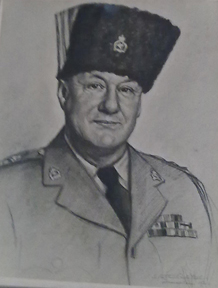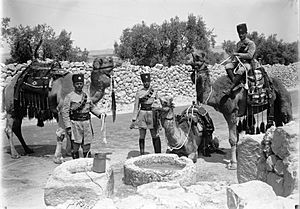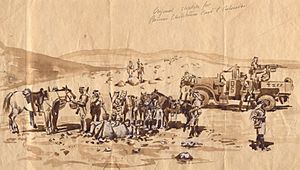Transjordan Frontier Force facts for kids
The Trans-Jordan Frontier Force (TJFF) was a special army unit created on April 1, 1926. Its main job was to protect the borders of Trans-Jordan (which is now Jordan) from the north and south. This force was set up by the British, who were in charge of the area at the time.
The TJFF was different from another local army called the Arab Legion. The Arab Legion mostly handled security inside Trans-Jordan. The TJFF, however, was an "Imperial Service" unit. This meant its soldiers could be sent to serve in other British-controlled areas, not just their home country. Amir Abdullah, the ruler of Trans-Jordan, was an honorary leader of the TJFF from the start.
Contents
History of the TJFF
The Trans-Jordan Frontier Force began its training in a place called Sarafand. It started with soldiers from the Arab Legion. Soon, it grew to include three groups of cavalry (soldiers on horses) and an infantry unit (soldiers who fight on foot). Each cavalry group had about 120 men. The first leader of the TJFF was Lieutenant-Colonel Frederick William Bewsher. Later, new units were added, like a camel unit and groups with vehicles.
The TJFF was given modern weapons and training. This was different from the Arab Legion, which at first used more traditional methods and less technology. Because of this, the Arab Legion gave its machine guns, artillery, and radios to the TJFF.
After World War II, Trans-Jordan became an independent country. This meant there was no longer a need for a special British-controlled force like the TJFF. So, on February 9, 1948, the Trans-Jordan Frontier Force, which had about 3,000 members, was officially ended. Most of its soldiers then joined the Arab Legion.
How the TJFF Was Organized
The TJFF was part of the British military forces in Palestine and Trans-Jordan. Its main office was in Zerqa, a city in Trans-Jordan. The top commander of the TJFF was a British lieutenant colonel.
The second-in-command was a British major. This officer was in charge of things like supplies, workshops, and paying the soldiers. Another British major was the adjutant, who handled training and personnel. An Arab officer helped the adjutant.
Each squadron (a group of cavalry) and company (a group of infantry) was led by a British major. Another British officer was their second-in-command. The cavalry squadrons had three rifle troops and one machine gun troop. A "half-squadron" or "half-company" was a common smaller unit for fighting or scouting. These were led by local captains.
By the end of 1927, the TJFF had 39 officers, including 17 British officers. It also had 12 British warrant officers and 676 other soldiers. In 1930, there were 17 British officers. By 1935, this number grew to 24 British officers.
The TJFF spent its first six months training in Palestine. Then, its main office moved to Zerqa, east of the Jordan River. The cavalry groups were based in Zerqa, and the camel company was in Ma'an. In 1929, the TJFF helped with unrest in Palestine. The camel company moved to Jericho, and a cavalry group went to Jisr el Majamie.
In 1930, a new unit with vehicles (mechanised company) was formed in Ma'an. The camel companies were then stopped. Using vehicles helped the TJFF cover more ground in the desert. By 1930, the TJFF had 980 men, including 28 Jewish soldiers.
Leaders of the TJFF
The TJFF had several important leaders during its time:
- Lieutenant-Colonel F. W. Bewsher: The first commander from 1926 to 1928.
- Major C. A. Shute: Led the force from 1928 to 1933.
- Major C. H. Miller: Commander from 1933 to 1936.
- Lieutenant-Colonel J. I. Chrystall: Led from 1936 to May 1940.
- Lieutenant-Colonel P. L. Wilson: Commander from May 1940 to 1946.
- Colonel John Hackett: The last commander, from 1946 until the force was disbanded in 1948.
TJFF Units and Regiments
The TJFF was made up of different types of units over time:
- HQ Wing: The main headquarters unit, active throughout the TJFF's existence.
- "A", "B", and "C" Squadrons: These were cavalry (horse-mounted) units from 1926 to 1941.
- Camel Company: Used camels for transport and patrols from 1926 to 1930. It was then replaced by units with vehicles.
- "D" Company (Mechanised): A unit with vehicles, formed in 1930. It was based at the H4 pumping station on the Iraq Petroleum Company pipeline.
- "E" Company (Mechanised): Another unit with vehicles, formed in 1933.
- Mobile Guard Squadron: Formed in 1941 to protect important roads.
Later, these units were grouped into larger regiments:
- 1st Cavalry (Horsed) Regiment: Formed in 1941, it included the "A", "B", and "C" Cavalry Squadrons. It was based at Jisr el Majamie.
- 1st Mechanised Regiment: Formed in 1941, it included the "D", "E", and "L" Mechanised Squadrons. It was based at Irbid.
Who Joined the TJFF?
The first soldiers in the TJFF mostly came from another disbanded police force called the Palestine Gendarmerie. About 70% of the regular soldiers were Palestinian Arabs. Before 1930, some Sudanese soldiers were part of the camel company.
People who were better educated, like some Jewish and Arab individuals, often worked in technical or office jobs within the force. By 1935, nearly a quarter of the TJFF soldiers were Circassians. These are a small Muslim group living in Trans-Jordan.
While the top leaders were British Army officers, the junior officers came from various backgrounds. They included Arabs, Circassians, Sudanese, and a few Jewish officers. In 1930, out of 980 men in the TJFF, 28 were Jewish.
See also
- Trans-Jordan Frontier Force Long Service and Good Conduct Medal




